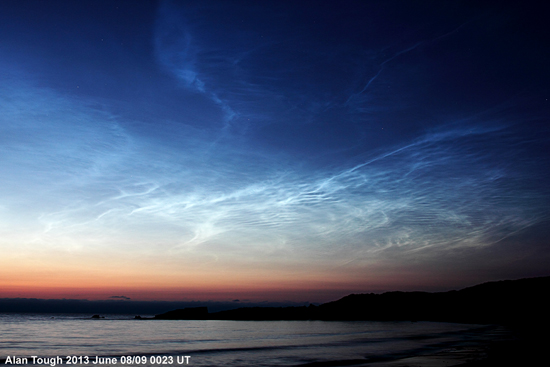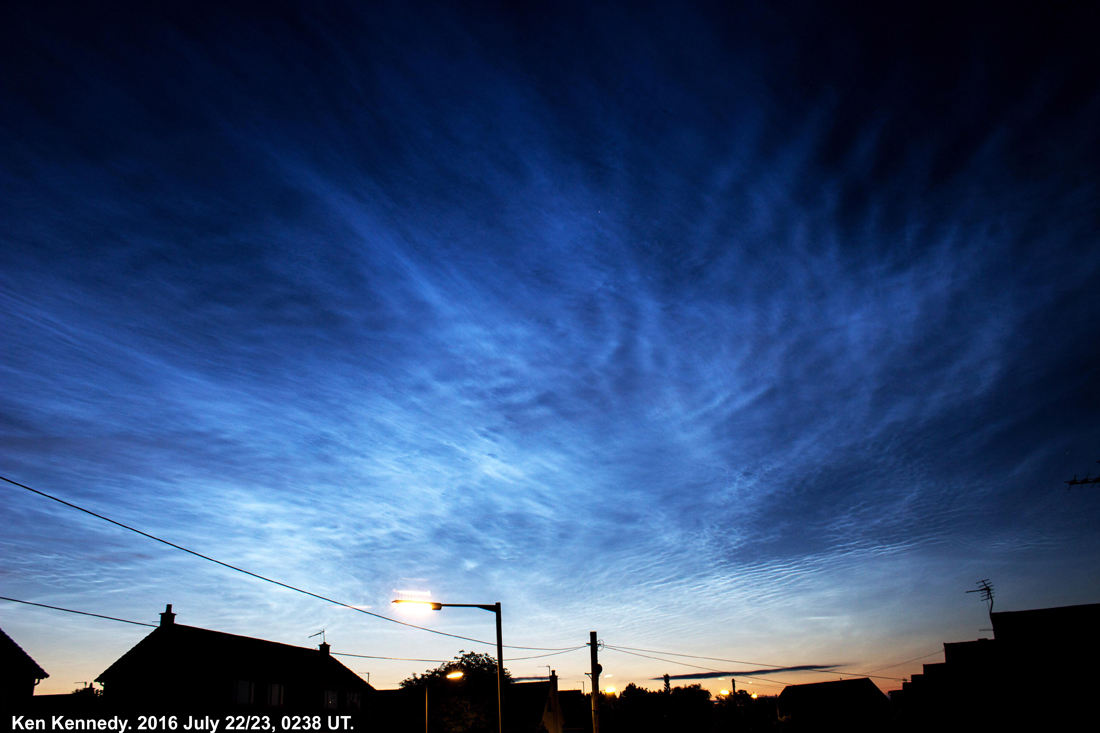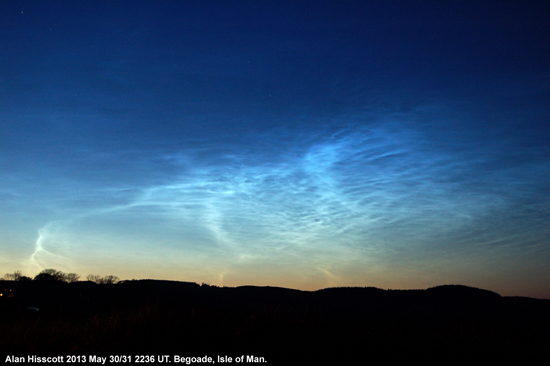By Ken Kennedy
We all hope for a fair bit of sunshine during our northerly summer months but the suggestion that clouds may appear in the summer sky will not be a concept too alien to most of us. However, the clouds I am thinking about are not the cumulous or even stratus type clouds you may well expect on many (well, perhaps most) summer days. In fact these clouds will not be making their appearance during any summer day but could appear an hour or so after the Sun has set and disappear about an hour before sunrise.
First recorded sightings
On June 8, 1885 Thomas Backhouse in Kissingen, Germany became aware of wispy bluish-white clouds low down towards the north and north-west following a beautiful sunset just a bit earlier in the evening. It had become quite a habit for many people to watch the sunsets and sunrises following the eruption of Krakatoa in August 1883. Many of these were quite spectacular with pink and purple colours which were the result of changes to the light of the setting Sun by particles in the upper atmosphere pushed upwards by the violence of the volcanic eruption. What Backhouse saw on the night of the 8th June, however, was rather different. These clouds were a pearly white, tending towards blue in colour, not the garish colours produced by the volcanic sunsets. It is likely to have been the colourful sunsets which allowed the discovery of these still unusual clouds as a number of historians of astronomy have failed to find any realistic reference to them before 1885.
More reports of sightings of these clouds were made and, as they were seen during the late evening and night, were given the name noctilucent clouds (NLC) or night luminous clouds. Reports and frequency of sightings gradually increased into the 20th century by which time they became a serious curiosity which were creating some questions in the scientific world. It was generally agreed that rising warm air cools and moisture carried by that warm air forms water droplets as the air ascends. These form clouds which could extend upwards to around 15km. Beyond this, very little water could be carried, and certainly not sufficient to form these clouds which had been measured to be at the remarkable height of around 83km.
The clouds are formed of ice crystals and are illuminated by the Sun which is between 6 and 16 degrees below the observer’s horizon. James Paton, the then Director of the British Astronomical Association’s Aurora Section made an extensive study of NLC from his home in Abernethy until his death in 1974. Dr Mike Gadsden of Aberdeen University continued to make a detailed study of NLC from the Cromwell Tower of Aberdeen University until his death in 2003. I remember well Mike saying to me ‘These clouds shouldn’t exist. There should not be enough water at that height to allow visible ice clouds’. He also was the first person I heard who suggested that NLC may be a barometer of global atmospheric change (he said this before the phrase ‘global warming’ became popular).
As Director and Assistant Director of the British Astronomical Association I have been studying NLC seriously since 2006 although I first saw them over the Sidlaw Hills one summer evening in 1964. Looking back on the records of James Paton and Mike Gadsden I find that they and their band of observers sighted NLC on around 45 nights between the end of May and the beginning of August in the 1950s to the 1980s. My band of observers reached a total of 188 in 2014 and are spread across Europe from as far west as Kazakhstan through Scandinavia and into the UK. With the help of these observations, in some years totaling over 700, the number of nights on which NLC has been observed in a summer season has been extended to 71 in 2009 but dropped back to 47 in 2016.
The increase in reported frequency of NLC may be partly accounted for by the increase in numbers and distribution of observers in more recent years but most agree that there has been a real increase in frequency of NLC over the past 50 years or so. Another interesting fact which shows change in the distribution of ice forming in the mesosphere is that originally the latitudes at which NLC were observed was stated to be between 50 and 65 degrees north (in the northern hemisphere) but recent confirmed reports have been received from observers in Portugal and Italy with latitudes as far south as 39 degrees north.
How do Noctilucent Clouds form?
As mentioned previously, most of the water carried upwards by rising air from the troposphere will have been deposited at levels below 15km and the amount of moisture carried into the stratosphere and mesosphere is insufficient to produce ice clouds which could be seen by the reflected light of the Sun shining below the horizon. If sufficient water is not carried up by this mechanism we must look for another source of water at these altitudes. It is now recognized that the tropospheric temperature has risen over the past 100 years and this rise in temperature has resulted in rising sea temperatures and thawing permafrost. The result of this has been an increase in methane in the lower atmosphere and this will naturally be carried upwards on the summer buoyancy waves produced by the jet stream and natural land forms. Methane dissociates in the stratosphere resulting in water vapour being produced, and increasing methane in the atmosphere will result in more water vapour at higher levels, sufficient to form visible ice clouds at around 83km.
In addition to the problem of where the upper atmospheric water has come from, there are two more problems to be addressed. The first is that water vapour will only form ice crystals at these rarified atmospheric levels at very low temperatures. The coldest part of the atmosphere is the mesopause at around 89km and the temperature there does not usually drop to the required -125°C when water vapour will freeze. It may seem a bit of a paradox that the coldest temperatures required for NLC only happen in the summer months, mainly June and July, but in these months the tropospheric air is warmest and the strongest buoyancy waves are formed. However, in the summer adiabatic cooling of rising air is at its most effective and this allows the mesopause to cool to the required temperature relatively frequently. It should be noted that the mesopause never reaches this temperature during winter months so NLC will never occur at that time. In relation to NLC frequency, it would seem that as the tropospheric temperature rises, buoyancy waves will be stronger and produce the required temperature more frequently.
Clouds at all levels form as moisture is produced by rising air expanding and cooling and droplets of water form and grow in size. The formation of a water droplet is dependent on something round which it can form, a nucleating particle. In the lower atmosphere these particles are of dust or pollen carried upwards by tropospheric winds. At the height of the mesopause where ice can form from the water vapour there are virtually no particles from the lower atmosphere. So the next problem is where do the nucleating particles which allow the water to form ice crystals come from? The Earth is constantly encountering dust like grains or particles as it orbits the Sun. Most of these particles have been distributed by comets orbiting the Sun for many thousands of years and we see concentrations of them as meteor showers throughout the year. These small grains burn up in our atmosphere when the Earth plows into them and they leave some of their smallest residue at around 85 – 90km. It is now accepted that the material which forms the nucleus of the NLC ice crystals is the smoke like remnants of these meteors.
It seems that the process of forming NLC is that rising air, which is often referred to as buoyancy waves, carrying water vapour from the dissociation of methane reaches the mesopause at the critical temperature for ice formation. At this point the water vapour freezes round minute meteor dust particles and begins to fall under gravity. As the crystals fall they gather more water and become large enough to be seen at around 83km. (this varies with slightly different temperature gradients). As the fall they are ‘blown’ by upper atmospheric winds forming bands or waves but as they continue to fall they encounter warmer air and melt, becoming invisible. This cut off in temperature can often be quite dramatic with well-defined lower edges.
Space Science and the Significance of NLC
The increasing frequency of NLC has been noted for a number of years and I remember my friend, the late Dr Mike Gadsden, who was an expert on upper atmospheric physics working at Aberdeen University saying that he believed NLC were a barometer of atmospheric or climate change. Sadly Mike died in 2003 having written many papers on NLC and I would have loved to have heard his thoughts on developments in the investigation of NLC since then.
The behavior of NLC came to the notice of NASA and in 2007 they launched a satellite into polar orbit to study the ice in the polar mesosphere, the northern hemisphere between the end of May and beginning of August and the southern hemisphere in December and January. This satellite is known as AIM (Aeronomy of Ice in the Mesosphere) and carries a number of instruments to measure ice density, distribution and height. The analysis of the data from AIM was given to the Laboratory for Atmospheric and Space Physics at the University of Colorado. I contacted this department in 2008 and spoke to Prof Cora Randall who is the chief investigator of the CIPS (Cloud Imaging and Particle Size) instrument on board AIM. Cora was happy to provide me with data from this instrument and continues to do so but was also interested in the data which I was analyzing from the observers in Europe and UK. Since then I have sent my ground based data to Cora every year and this has been compared with the data from AIM. The outcome is that it has been found that the CIPS instrument was unable to record ice in the mesosphere at latitudes at which we were seeing it. Because of this and because of slight changes to the orbit of AIM, Cora has asked NASA to alter the algorithm used to produce the CIPS data. She said in an e-mail to me last year:
The reprocessing is particularly important at low latitudes – we believe that our new algorithm is more sensitive to the dimmest clouds, which appear at low latitudes. So we will be looking closely at how the low-latitude clouds change from year to year in our new processing.
This change was made in time for the southern hemisphere’s NLC season and I look forward to seeing if the changes made allow AIM to ‘see’ ice in the mesosphere at lower latitudes during the northern season this year (2017).

The Sun plays a part in determining the frequency of NLC sightings as this may alter over a number of years. By gathering data from those who worked on this before me together with my past 11 years’ worth of data I have produced a graph of NLC frequency against solar activity. The Sun has an approximately 11 year cycle when activity waxes and wanes with sunspots being the chief marker for this activity. From trough to peak of solar activity the Sun’s energy output varies by about 0.1%. At maximum, the Sun can produce more heat in the upper atmosphere and this will not allow the temperature at the mesopause to fall to the required temperature for ice nucleation as frequently as at solar minimum. The graph of NLC activity against solar activity shows a distinct inverse relationship with NLC being more frequently seen in the years closest to solar minimum.
From what has been gathered by ground based observers and by the data provided by the AIM satellite it suggests that Mike Gadsden’s idea about NLC being a barometer of atmospheric change was very prophetic. Water vapour in the upper atmosphere has increased in a parallel way to the increase in atmospheric methane. Atmospheric methane has increased as tropospheric temperature has increased. These relationships are becoming widely recognized and NLC frequency, brightness and more southerly latitude sightings may well reflect these atmospheric changes. NLC are not the cause of atmospheric change but the result of such changes and although they are an attractive sight on warm summer nights they may be harbingers of longer term and unwelcome alterations in our thin and fragile atmosphere.
Ken Kennedy
Coordinator of NLC observations in Europe and UK
Aurora Section. British Astronomical Association



